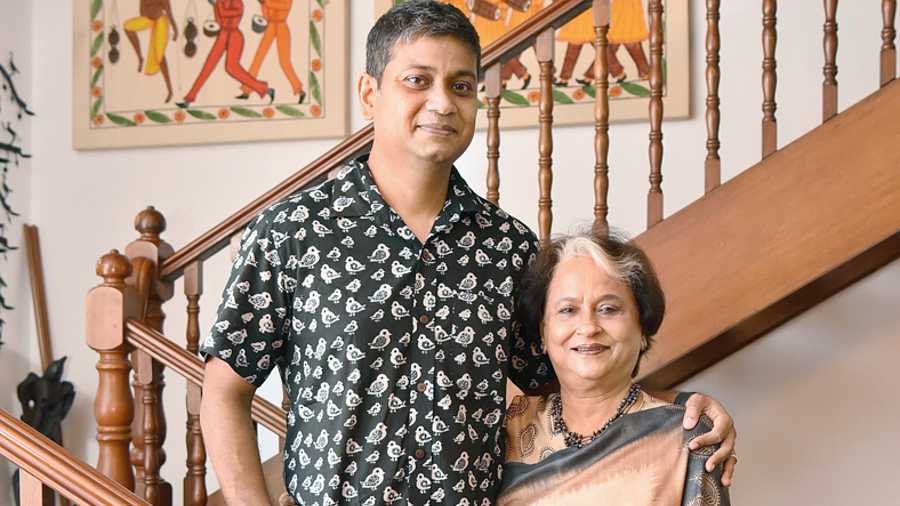The journey began in 1970 and has over the years grown into a “legacy business”. Kanishka’s, the brand started by Nandita and Dilip Raja, has become iconic, thriving on relationships and memories. Son Prateek Raja who was mostly behind the scenes, is now much more involved and at the forefront of taking Kanishka’s forward. The Telegraph caught up with Nandita and Prateek Raja on future plans and more.

Prateek and Nandita Raja at their Ballygunge Place residence. Picture: B. Halder
Prateek, 50 years is a huge landmark. Are you re-evaluating things?
Good question because when you hit a landmark, you re-evaluate many things that you have been doing. This landmark was a different one because of the pandemic. It made us think about how we are communicating with the people who come to our store. One of the things we realised is that what stands in good stead and brings people back are the relationships you build over the years. We have been trying to connect with all our customers, people who have been coming for generations to our store, through WhatsApp or doing virtual shopping visits for them. We also realised that there is an entire new generation of younger people who are also our customers but they are also customers of many other categories. They are not necessarily wearing a sari to work every day. In my understanding of how sari wearing is changing, the category itself is changing. What is important is every young person that we have spoken to, may be in their 20s and 30s and even up to 40s, even if they don’t wear saris every day, the minute they have an opportunity to wear a sari, they think of wearing Kanishka’s. So, how can we reach out to that customer base is something we have been working on.
We are at the moment in the midst of doing a multifunctional website. Of course buying things online is the objective of the website, but it also allows you an insight into how the brand is and the values of the brand and talks about our history and archives, our looms, printing processes and how we have held onto the traditional systems. We have actively resisted expanding into other formats of retail and invested in relationships to make people come to us rather than we go to them.
We have also been going back to our past designs. The processes adapt over time in general and you end up looking at things in a new way, but you also lose a lot of older processes and designs because they just become out of use. We have been going through our archives and trying to find things that defined us more than 30 years ago. Some of these designs will come back into production and they will be made differently to appeal to the new generation. We have been recutting many of our old blocks.
We also want to make ourselves more accessible, but we don’t want to be an Amazon. The facility is there, but that’s not the end goal.
Does any particular memory come to mind from your childhood days at Kanishka’s?
We have grown up in the textile aesthetic. If you ever stood in front of a block-printing table, it is really fascinating. Each sari has 6,000 odd impressions that have to be made and because each impression is handmade, there is a certain kind of sound that comes from the impressions. My absolute earliest memory is the sound... children remember phonetics. A block-printer’s hands has calluses. The printers would give me a scrap of cloth and I would make impressions on them.
I have vivid memories with the weavers. My parents in the late ’70s travelled extensively to weaving clusters in small, remote villages, starting with Odisha in the beginning and expanding down South to Andhra Pradesh and Tamil Nadu. What fascinated me was how the cloth is made, the food we had at their homes. We have grown with our weavers.
Nandita aunty, are you planning to relax a bit now?
Not at all! Ekhon toh uncle’r (we lost Dilip Raja last year) kaaj tao korte hochhe. Though Kanishka’s is in its 51st year, I am enjoying what I do. The love and appreciation I get from the customers motivates me to carry on. I’ll work till the time my health permits.
We are sure you miss Dilip uncle a lot every single moment, but when it comes to work, what do you miss the most about him not being there?
When I look at his sketches, I think ei sketch toh aami korte parbo na. He was so talented and without any basic training. Ei talent aami aar pabo na. Every design has his signature touch. I miss his guidance. He had a vast knowledge of textiles.
Prateek, so a lot of responsibilities?
Too much, but I realised that Kanishka’s is not just a product, but a way of life. It’s an emotion for many and it’s a pioneering way of looking at what can be worn or how you develop an aesthetic for an individual. Kanishka’s loyal customer has developed a certain aesthetic. It has gone beyond the design of the sari or the experience of the store... it’s a kind of feeling. If I was to think of the future, Priyanka (wife and co-founder, Experimenter gallery) and my objective would be to keep the essence of Kanishka’s, the brand value, in terms of what it gives you, non-materially or as a feel. In my opinion, it’s got a very wide future but roots itself back essentially to the handmade, celebrating the skilled craftsman....
Nandita aunty, what are the festive bestsellers?
Our tussores. Our customers love our traditional designs and keep coming back for that.
What are your messages for each other?
Prateek Raja: My mother needs to work to be sane because it is a way of life for her as well. I get the greatest pleasure when I see her going to the factory or interacting with the customers. That has set up a discipline in her life in the lockdown. My message to her would be to continue what she is doing and we’ll be there to support her in her vision. The memory of my father can be kept alive through the work that he did.
Nandita Raja: Aami oder gharer opor kichhu chapiye dite chai na. We have done things according to us. Priyanka and Prateek oder moto korte pare... bhalobeshe.
